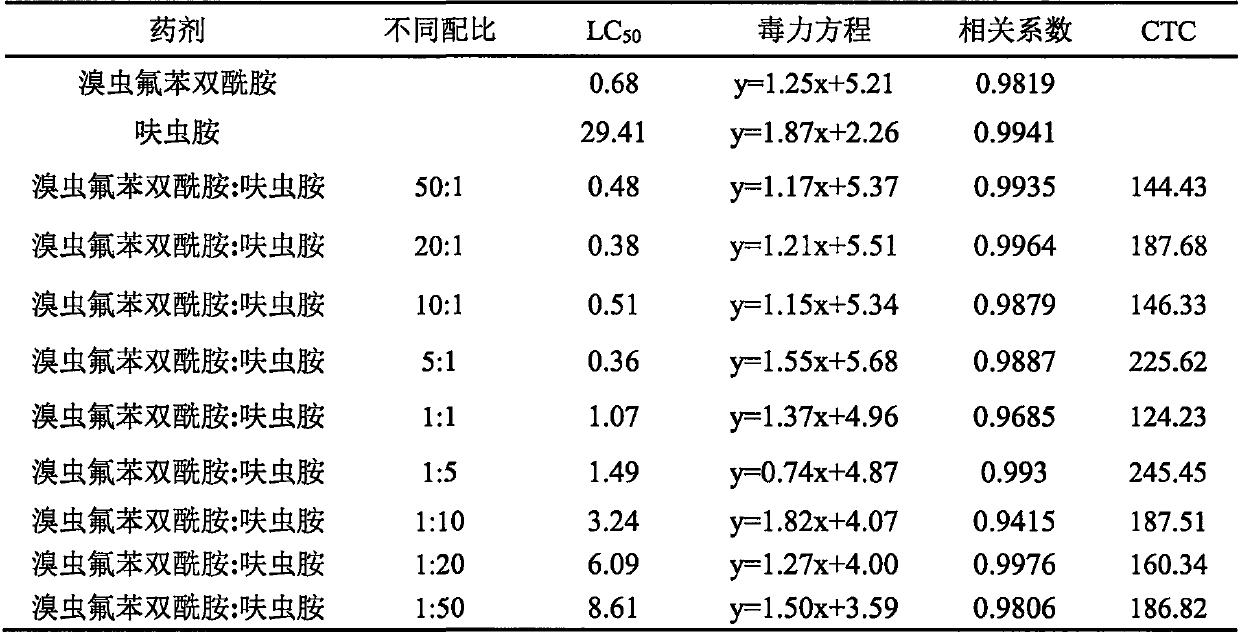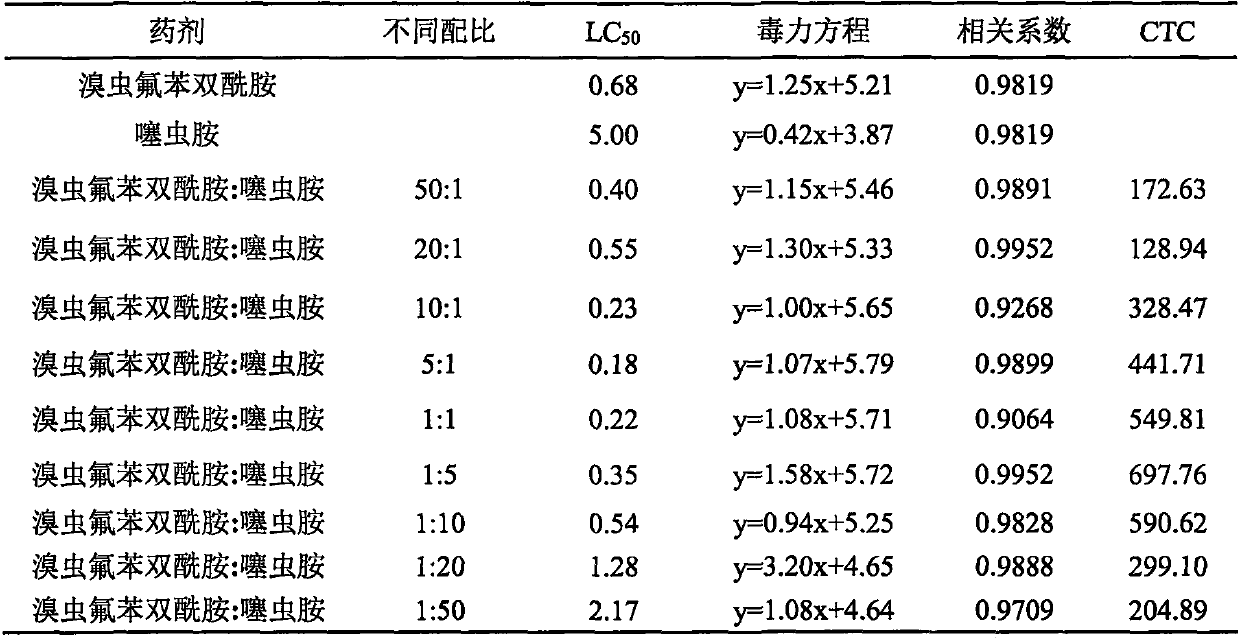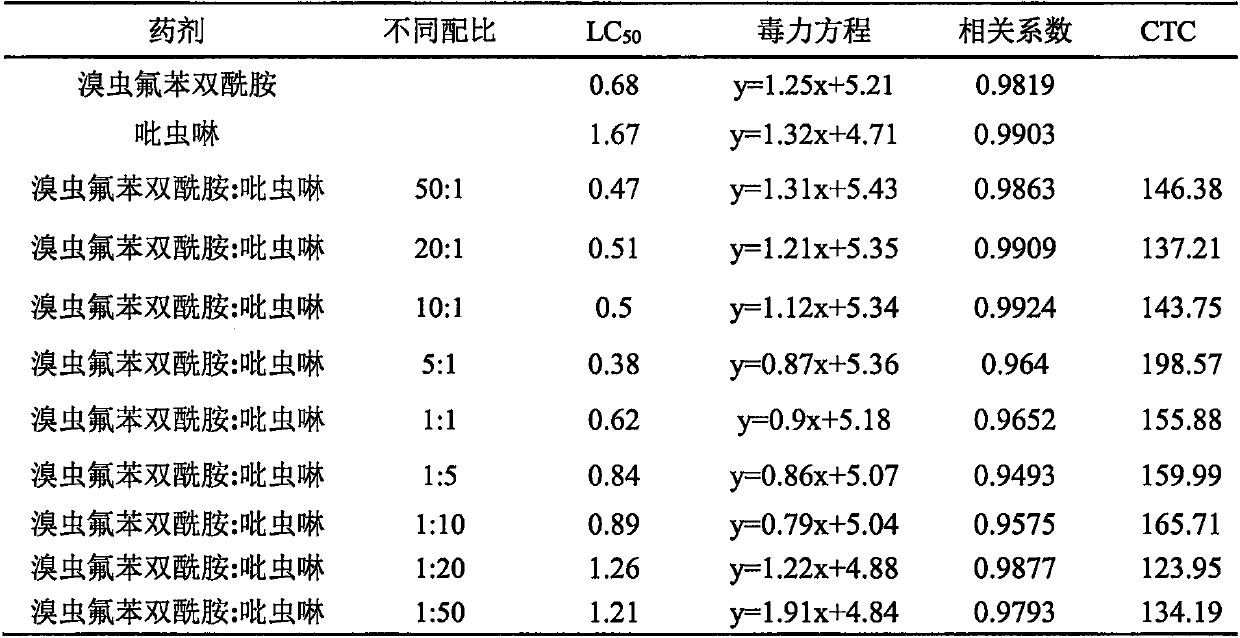Synergistic pesticide composition containing chlorfenapyr fluorobenzene bisamide and neonicotinoid insecticide
A technology of bromflubendiamide and a pesticide composition, which is applied in the field of pesticides and can solve problems such as pollution, pesticide residue environment, and pests' easy resistance to pesticides
- Summary
- Abstract
- Description
- Claims
- Application Information
AI Technical Summary
Problems solved by technology
Method used
Image
Examples
Embodiment 1
[0030] Example 1: Combined toxicity test of different ratios of bromflubendiamide and dinotefuran on cotton aphids.
[0031] 1. Prepare the pesticide raw material with organic solvent DMF or DMSO to make a 1%-5% mother solution, and then dilute the pesticide mother solution with an aqueous solution containing 0.1%-Tween to form 5-7 serial determination solutions;
[0032] 2. Immerse the cotton leaf with cotton aphid directly in the liquid to be tested for 5 seconds, take it out and put it into a clean petri dish, dry and seal it; repeat 3 times for each liquid. Check the mortality after keeping in the light incubator at (27±1)°C for 24 hours;
[0033] 3. Criterion for judging death: lightly touch the worm body with a needle and no response or uncoordinated response is considered dead;
[0034] 4. Statistically analyze the test results with the probability value method to obtain the toxicity regression line and LC 50 value etc. The co-toxicity coefficient (CTC value) of the ...
Embodiment 2
[0047] Example 2: Combined toxicity test of different ratios of bromflubendiamide and clothianidin against green peach aphid.
[0048] 1. Prepare the pesticide raw material with organic solvent DMF or DMSO to make a 1%-5% mother solution, and then dilute the pesticide mother solution with 0.1% Tween aqueous solution to form 5-7 series of concentration determination solutions;
[0049] 2. Immerse the leaves of cabbage with peach aphid directly in the liquid to be tested for 5 seconds, take it out and put it into a clean petri dish, dry and seal it; repeat 3 times for each liquid. Check the mortality after keeping in the light incubator at (27±1)°C for 24 hours;
[0050] 3. Criterion for judging death: lightly touch the worm body with a needle and no response or uncoordinated response is considered dead;
[0051] 4. Statistically analyze the test results with the probability value method to obtain the toxicity regression line and LC 50 value etc. The co-toxicity coefficient (...
Embodiment 3
[0064] Example 3: The joint toxicity test of different ratios of bromflubendiamide and imidacloprid on citrus psyllids.
[0065] 1. Prepare 2% mother liquor by using organic solvent DMF or DMSO as the original pesticide, and then prepare 5 assay liquids with the aqueous solution of 0.05% Triton X-100, a universal emulsifier;
[0066] 2. Collect tender branches with citrus psyllid nymphs from the field, remove excess leaves, and wrap the base of the branches with wet cotton to keep them moisturized. The shoots and leaves with nymphs were dipped in the prepared liquid for 10 seconds, dried, and the number of nymphs was counted. The base of the branches soaked in the medicinal solution is plunged into the finger tube water to keep the branches fresh for a long time. About 30 heads were treated and repeated 3 times. After treatment, put them in a light incubator at 27°C±1°C for recovery. Mortality was counted 3 days after administration. ;
[0067] 4. Statistically analyze th...
PUM
 Login to View More
Login to View More Abstract
Description
Claims
Application Information
 Login to View More
Login to View More - R&D
- Intellectual Property
- Life Sciences
- Materials
- Tech Scout
- Unparalleled Data Quality
- Higher Quality Content
- 60% Fewer Hallucinations
Browse by: Latest US Patents, China's latest patents, Technical Efficacy Thesaurus, Application Domain, Technology Topic, Popular Technical Reports.
© 2025 PatSnap. All rights reserved.Legal|Privacy policy|Modern Slavery Act Transparency Statement|Sitemap|About US| Contact US: help@patsnap.com



